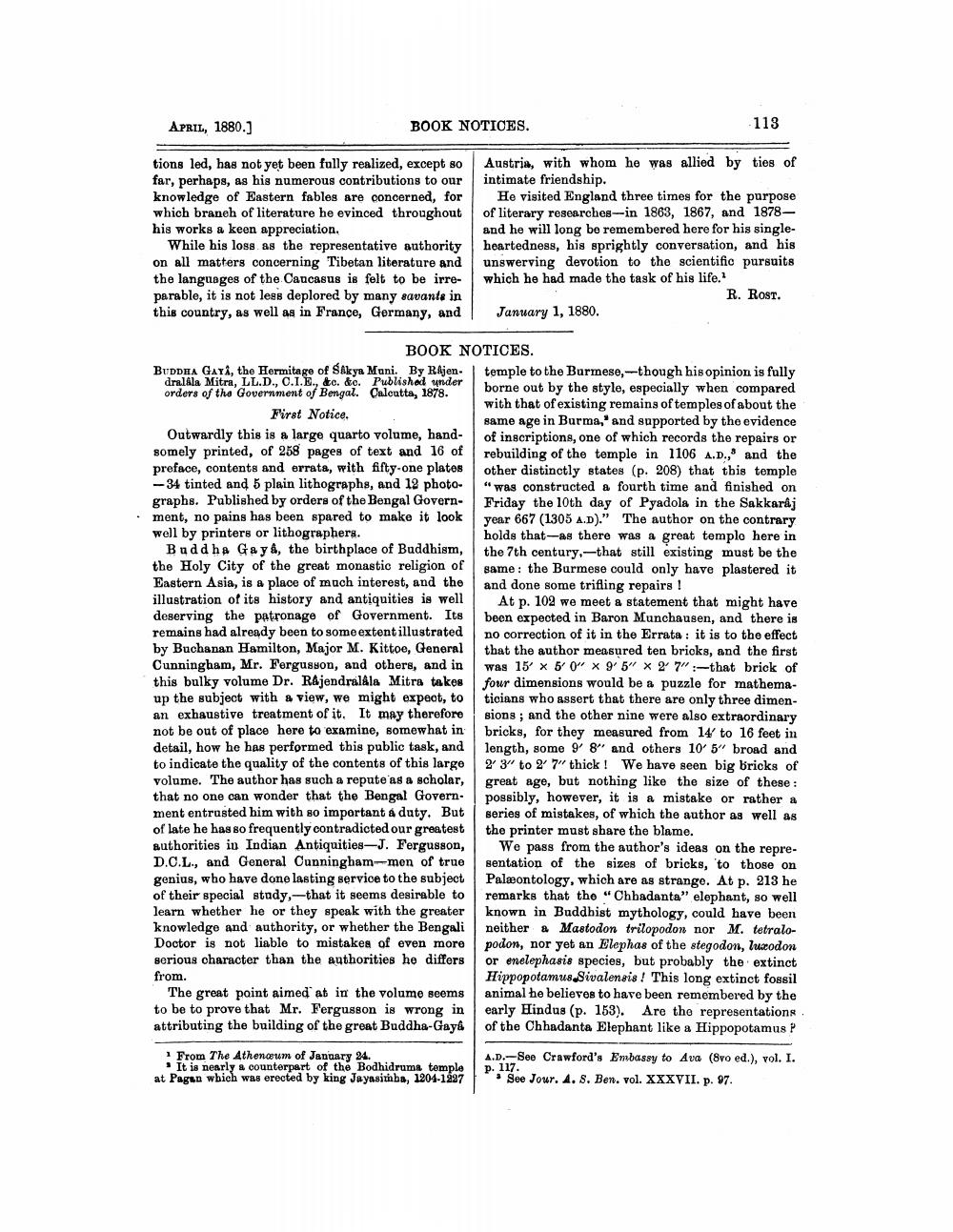________________
APRIL, 1880.]
BOOK NOTICES.
113
tions led, has not yet been fully realized, except so far, perhaps, as his numerous contributions to our knowledge of Eastern fables are concerned, for which branch of literature he evinced throughout his works a keen appreciation.
While his loss as the representative authority on all matters concerning Tibetan literature and the languages of the Caucasus is felt to be irreparable, it is not less deplored by many savanta in this country, as well as in France, Germany, and
Austria, with whom he was allied by ties of intimate friendship.
He visited England three times for the purpose of literary researches--in 1863, 1867, and 1878and he will long be remembered here for his singleheartedness, his sprightly conversation, and his unswerving devotion to the scientific pursuits which he had made the task of his life.
R. Rost. January 1, 1880.
BOOK NOTICES. BUDDHA GAYA, the Hermitage of SAkya Mani. By Rajen. temple to the Burmese,--though his opinion is fully dralkla Mitra, LL.D., O.I.E., &c. &c. Published under orders of the Government of Bengal. Calcutta, 1878.
borne out by the style, especially when compared
with that of existing remains of temples of about the First Notice.
same age in Burma," and supported by the evidence Outwardly this is a large quarto volume, hand- of inscriptions, one of which records the repairs or somely printed, of 258 pages of text and 16 of rebuilding of the temple in 1106 A.D.,' and the preface, contents and errata, with fifty-one plates other distinctly states (p. 208) that this temple -34 tinted and 5 plain lithographs, and 12 photo- "was constructed a fourth time and finished on graphs. Published by orders of the Bengal Govern- Friday the 10th day of Pyadola in the Sakkaraj ment, no pains has been spared to make it look year 667 (1305 A.D)." The author on the contrary well by printers or lithographers.
holds that--as there was a great templo here in Buddha Gayi, the birthplace of Buddhism, the 7th century--that still existing must be the the Holy City of the great monastic religion of same: the Burmese could only have plastered it Eastern Asia, is a place of much interest, and the and done some trifling repairs ! illustration of its history and antiquities is well At p. 102 we meet a statement that might have deserving the patronage of Government. Its been expected in Baron Munchausen, and there is remains had already been to some extent illustrated no correction of it in the Errata : it is to the effect by Buchanan Hamilton, Major M. Kittoe, General that the author measured ten bricks, and the first Cunningham, Mr. Fergusson, and others, and in was 15 X 50" X 9' 5" X 27" :-that brick of this bulky volume Dr. Rajendralkla Mitra takes four dimensions would be a puzzle for mathemaup the subject with a view, we might expect, to ticians who assert that there are only three dimenan exhaustive treatment of it. It may therefore sions; and the other nine were also extraordinary not be out of place here to examine, somewhat in bricks, for they measured from 14 to 16 feet in detail, how he has performed this public task, and length, some 9 8" and others 10' 5" broad and to indicate the quality of the contents of this large 23 to 27" thick! We have seen big bricks of volume. The author has such a repute'as a scholar, great age, but nothing like the size of these : that no one can wonder that the Bengal Govern- possibly, however, it is a mistake or rather a ment entrusted him with so important a duty. But series of mistakes, of which the author as well as of late he has so frequently contradicted our greatest the printer must share the blame. authorities in Indian Antiquities-J. Fergusson, We pass from the author's ideas on the repreD.O.L. and General Cunningham--men of true sentation of the sizes of bricks, to those on genius, who have done lasting service to the subject Palæontology, which are as strange. At p. 213 he of their special study,--that it seems desirable to remarks that the "Chbadanta" elephant, so well learn whether he or they speak with the greater known in Buddhist mythology, could have been knowledge and authority, or whether the Bengali neither a Mastodon trilopodon nor M. tetraloDoctor is not liable to mistakes of even more podon, nor yet an Elephas of the stegodon, lucodon serious character than the authorities he differs or enelephasis species, but probably the extinct from.
Hippopotamus.Sivalensis ! This long extinct fossil The great point aimed at in the volume seems animal he believes to have been remembered by the to be to prove that Mr. Fergusson is wrong in early Hindus (p. 153). Are the representations attributing the building of the great Buddha-Gaya of the Chhadanta Elephant like a Hippopotamus P
1 From The Athenaeum of January 24.
It is nearly a counterpart of the Bodhidruma temple at Pagun which was erected by king Jayasimba, 1204-1827
A.D.-See Crawford's Embassy to Ava (8vo ed.), vol. I. p. 117.
. See Jour. A. S. Ben. vol. XXXVII. p. 97.




